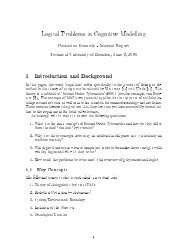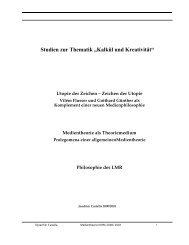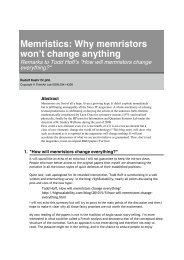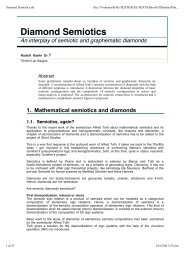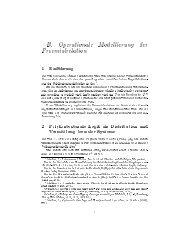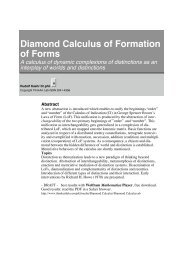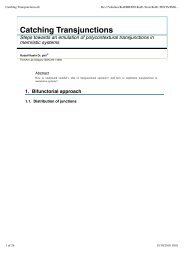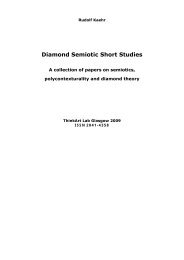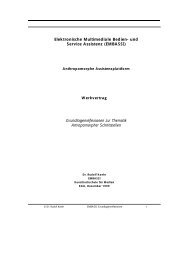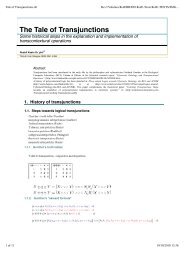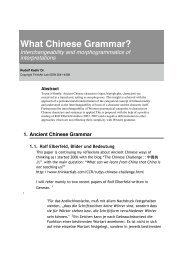Toth's semiotic diamonds - ThinkArt Lab!
Toth's semiotic diamonds - ThinkArt Lab!
Toth's semiotic diamonds - ThinkArt Lab!
Create successful ePaper yourself
Turn your PDF publications into a flip-book with our unique Google optimized e-Paper software.
6 <strong>Toth's</strong> Semiotics.nb<br />
Toth’s general procedure<br />
"Die semiotische Rejektionsfunktion ist nun aber keineswegs auf den Strukturtyp (e.f c.d a.b) wie im obigen<br />
semiotischen Diamanten beschränkt. Semiotische Inversion (INV) ist allgemein durch folgende zwei<br />
Anweisungsschritte erreichbar:<br />
1. Kehre die Reihenfolge der konstituierenden Subzeichen einer Zeichenklasse (oder einer ihrer Transpositionen<br />
bzw. Dualisationen) um.<br />
2. Vertausche alle semiotischen Morphismen mit ihren Inversen (wobei natürlich z.B. a°°= a, b°° = b und per<br />
definitionem (vgl. Toth 1993, S. 21 ff.) (ba)° = a°b° und (a°b°)°= ba gilt.”<br />
INV - Rules<br />
I. a±± = a, b±± = b,<br />
II. HbaL ± = a±b±,<br />
III. id± = id<br />
Ha±b±L ± = Hb±± a± ± L = ba HIV.L<br />
Hence, there are two steps to consider for the construction of a hetero-morphism in a <strong>semiotic</strong> diamond:<br />
1. Chiasm: Change the order of subsigns.<br />
2. Inversion: Exchange all <strong>semiotic</strong> morphisms with their inversion.<br />
This can be reformulated by:<br />
1. Apply the inverse operation INV to the parts (A 3 , B 3 ) of an (acceptional) morphism (morph 3 L .<br />
An acceptional morphism is the composition of two basic morphism of a <strong>semiotic</strong> category.<br />
2. Substitute the results of the first part, (A 3 L, of the morphism with the second part, (B 4 ), of the heteromorphism,<br />
morph 4 , to be constructed. And the same procedure with the second part, (B 3 L; substitute it with the<br />
first part (A 4 L of the hetero-morphism morph 4 .<br />
And additionally:<br />
3. Positioning, difference, matching conditions<br />
3.1 The second part of the first morphism, its codomain or target, and the first part of the hetero-morphism, its<br />
domain, source, have to be matched.<br />
3.2 The first part of the second morphism, its domain or source, and the second part of the hetro-morphism, its<br />
codomain, target, have to be matched.<br />
A hetero-morphism is the rejectional morphism of an acceptional morphism. But this distinction has first to be<br />
established. Without the distinction between acceptional and rejectional morphism, the constructed heteromorphism<br />
is not yet placed. To realize its correct placement, a new condition has to be fulfilled. It is the role of the<br />
difference relations to organize such a placement of a not yet positioned hetero-morphism.<br />
It seems that Toth’s approach is not considering this part of the construction.<br />
Semiotic hetero - morphism construction<br />
" morph HA 3 , B 3 L, HA 4, B 4 L œ SEMIOTICS<br />
IF<br />
HA 3 , B 3 L œ Morph<br />
Subst<br />
IINVIA 3 MëB 4 MÔ Subst<br />
IINVIB 3 MëA 4 M<br />
THEN<br />
HA 4, B 4 L œ Het - M orph.<br />
Schemes of inversion and exchange<br />
aL intended scheme?<br />
C ô A : heter<br />
» ? » ?<br />
HA B L o HB öC L : comp<br />
…<br />
…<br />
A C : morph



